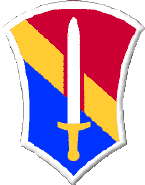

 |
|
|
 |
|
 |
|
 |
|
 |
|
 |
|
 |
|
 |
|
|
|
|
|
|
|
|
Shoulder Sleeve Insignia |
Distinctive Unit Insignia |
History - I Field Force, VietnamArrived in Vietnam of March 15, 1966
Departed Vietnam April 30, 1971
Authorized Headquarters Strength: 1966, 340; 1968, 432; 1971, 263Increased roles of U.S. combat units in field operations spurred creation of a provisional Field Force headquarters in the II Corps Tactical Zone zone on 1 August 1965. It was called Taskforce ALPHA (Provisional). Field Force, Vietnam was created from this basis and was redesignated I Field Force, Vietnam on March 15, 1966. The field force concept was adopted instead of a normal corps headquarters for three basic reasons:
1. Since the headquarters was to operate within an existing South Vietnamese Corps zone, it would be confusing to introduce another Corps designation within the same zone;
2. Unlike a corps headquarters, which has only tactical functions, the field force was to have additional responsibilities such as supply, pacification and an advisory role to the South Vietnamese;
3. The field force organization was more flexible, making it possible to add additional subordinate units if required, even including subordinate corps headquarters.
I Field Force Vietnam had the mission of exercising operational control over the U.S. and allied forces in the II Corps Tactical Zone as well as providing combat assistance to the Vietnamese units in the area. I Field Force Vietnam was used as a basis for the Second Regional Assistance Command (SRAC) on April 30, 1971 and U.S. Military Forces, Military Region 2.
Organized in Fort Hood, Texas in early 1965 with cadres from III Corps, I (pronounced "eye") Field Force Vietnam (originally Taskforce ALPHA) arrived in Vietnam on August 1st, 1965 to provide combat assistance to the South Vietnamese Army's II Corps and to control U.S. military operations in the Central Highlands. Headquartered at Nha Trang, it was redesignated I Field Force Vietnam, a corps-level organization, in March 1966.It's assigned units included the 41st and 52nd Artillery Groups as well as various combat support and combat service support battalions. Attached to I Field Force Vietnam at one time or another for specific operations were the U.S. First Cavalry Division (Airmobile); the Fourth Infantry Division; the 3d Brigade, 25th Infantry Division; the 1st Brigade, 101st Airborne Division (Airmobile): and the 173rd Airborne Brigade (Separate).
As part of the U.S. military withdrawal, I Field Force Vietnam was disbanded on April 30th, 1971.
Central Highlands
The term "Central Highlands" was used to describe a highland area of the western part of all II Corps stretching roughly from Ban Me Thout in Darlac Province north to Kontum Province and the southern border of I Corps. An area of approximately 5,400 square miles, it was sparsely populated, primarily by Montagnard tribesmen.
Recognized early by North Vietnamese Army (NVA) strategists as a key to the conquest of Vietnam, an NVA attempt to cut Vietnam in two in 1965 with an attack from Cambodian sanctuaries across the Central Highlands to the sea was foiled by the U.S. First Cavalry Division in the Battle of Ia Drang.
In 1975 they repeated this same strategy with the three division attack on Ban Me Thout on March 10th, 1975. In the face of this attack, South Vietnamese President Nguyen Van Thieu made the decision on March 14, 1975 to withdraw his overextended forces from the highlands to coastal enclaves. Under increasing NVA pressure, this withdrawal turned into a route. By March 31, 1975 the NVA 320th Division reached Tuy Hoa on the coast of the South China Sea. South Vietnam had been cut in two, and a month later Saigon fell to the NVA.
Suggestions for Further Reading
Command and Control 1950 to 1969, by George S. Eckhardt (Washington D.C.: U.S. Government printing Office, 1974)
The Vietnam War Almanac, Harry G. Summers Jr., Colonel of Infantry (Novato, California: Presidio Press, 1985, republished 1999)
Vietnam Order of Battle, by Shelby L. Stanton (Washington D.C.: U.S. News and World Report Books, 1981)

|
All contents © 2002 Association of
the First Field Force Vietnam.
|

